The shepherd of D-Day
A tattered flag that oversaw the invasion of Normandy in 1944 is finally coming home.
D-Day. June 6, 1944.
The words bring to mind images of hundreds of landing craft, machines, and American fighting forces landing on the beaches of faraway places. D-Day was the largest seaborne invasion in modern history. Thousands of soldiers, sailors, and airmen of the Allied Expeditionary Forces invaded Normandy to liberate Western Europe during World War II.
And this flag was there.
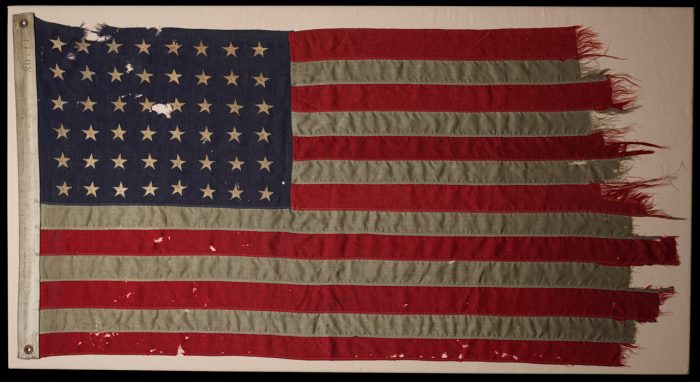
This flag, which flew aboard LCC 60 on D-Day, was donated by Bert Kreuk and Theo Schols to the people of the United States in memory of the service and sacrifices made by all Americans in the liberation of Europe during World War II. (Photo by Jaclyn Nash)
In the early hours of D-Day, a massive naval armada floated several miles off the enemy-held coast of France. The ships would soon deliver soldiers to five beaches. Aboard the ships, orders bellowed over loudspeakers, telling soldiers to stand by and prepare to board an array of landing craft to bring them to shore.
A few specialized ships, called “Landing Craft, Control” or “LCC,” would guide the vessels carrying tanks and personnel to the correct sectors of the beaches and help control the movement as vessel after vessel approached the shore.
This flag flew aboard LCC 60, a vessel that guided waves of swimming tanks and landing craft to the “Tare Green” and “Uncle Red” sectors of Utah Beach.
LCC 60 was captained by a 26-year-old English major from Oskaloosa, Iowa: Lieutenant (junior grade) Howard Vander Beek. His orders were to move LCC 60 into its position as a secondary control ship, providing backup to the primary control ship and guiding landing craft to “Tare Green.”
As they waited, Vander Beek and his crew heard enemy shellfire directed at them. Suddenly, the primary control vessel for “Uncle Red” sank—victim of an enemy sea mine. Moments later, in LCC 60’s sector, a landing craft carrying tanks struck a sea mine and sank.
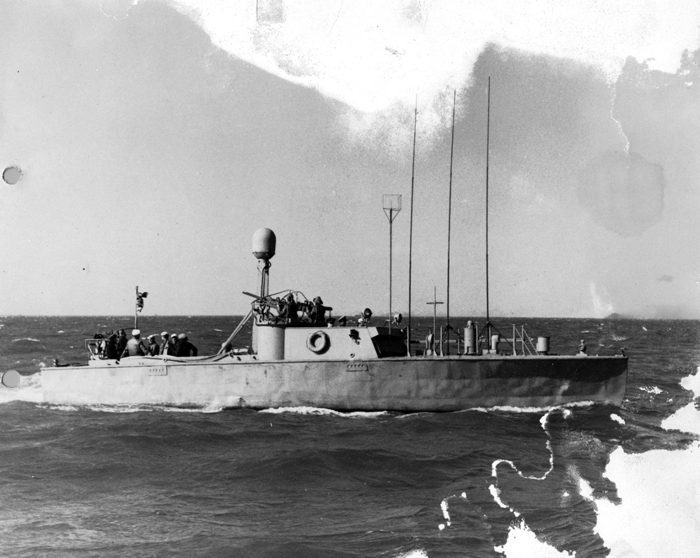
Landing Craft, Control (LCC) were 56 feet long and cruised at a maximum speed of 13.5 knots, about the size of many modern sport fishing boats. They had practically no creature comforts for their 14-person crew, and the little craft sported considerable specialized equipment, including radar and radio transmitters, direction finders, and underwater sound equipment. Courtesy of the Naval History and Heritage Command.
Meanwhile, a deafening roar swept the area as American bomber aircraft hammered the beaches. Naval gunfire erupted, with dust and smoke soon enveloping the entire coastline ahead of LCC 60.
Vander Beek received word that his craft’s counterpart in “Uncle Red,” LCC 80, was unable to maneuver after a buoy line fouled the propeller. The primary control ship for “Tare Green” directed LCC 60 to shepherd all the invading ships to shore in “Uncle Red” as well as continue providing support for “Tare Green.”
As the sun began to rise, Vander Beek turned to see what he called “the greatest armada the world had ever known, the greatest it would ever know” behind him.
He later recalled the “many great, gray ships majestically poised in their positions; larger numbers of unwieldy landing vessels heaved by the heavy sea; and countless numbers of smaller amphibious craft tossed mercilessly by the waves.”
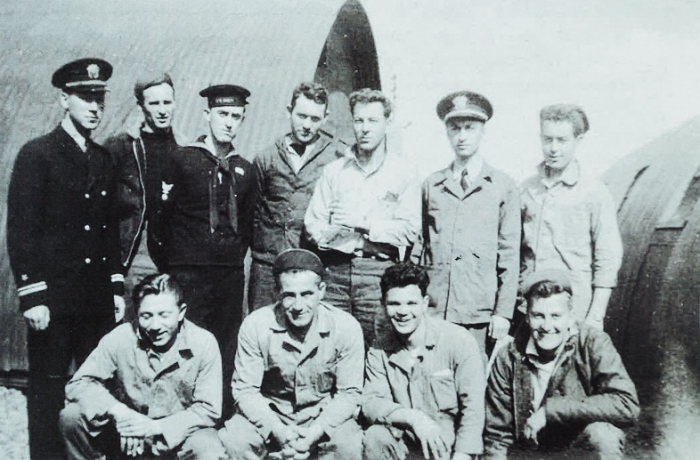
Crew of LCC 60. Courtesy of Heritage Auctions.
Then the aquatic invasion began.
LCC 60 helped move the tank landing craft in closer, then turned to control duties in “Uncle Red,” directing waves of tanks and men ashore.
Unbeknownst to the men of LCC 60, the combination of limited visibility with a strong ocean current and winds caused the first wave of landing craft they directed to come ashore about 1,000 to 1,500 yards south of the intended landing zone. Fortunately, this section of the beach had few obstacles and even fewer defenders. Among the men landing on that section of beach was Brigadier General Theodore Roosevelt Jr., Assistant Division Commander of the Fourth Infantry. He scouted the landing area and declared, “We’ll start the war from right here!”
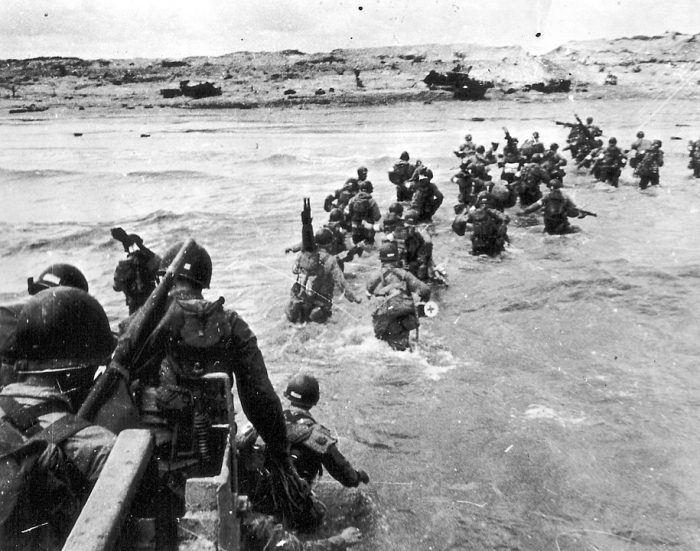
Soldiers disembarking on Utah Beach. Courtesy of the Conseil Régional de Basse-Normandie / National Archives.
The LCC 60 was relieved of her duties that afternoon. Vander Beek was summoned to brief senior leaders and war correspondents on the landings. After answering their questions, he returned to LCC 60 and spent the remainder of the day shuttling personnel from ship to ship. “Finally, somehow, the day that had begun an eternity before back in England ended sometime before the sun set,” he recalled.
In published recollections of his wartime experiences, Vander Beek never mentions his one souvenir of D-Day: LCC 60’s flag. The 48-star flag, its leading edge tattered and worn from ocean winds, was used at D-Day and again in a later invasion of Southern France, Operation Dragoon. A circular hole found in the blue field is believed to have been made by an enemy machine gun bullet off Utah Beach.
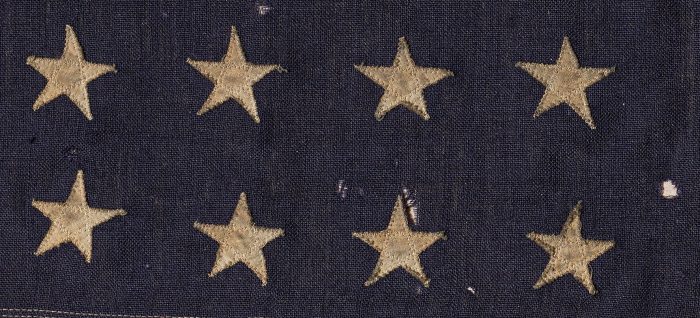
A circular hole found in the blue field is believed to have been made by an enemy machine gun bullet off Utah Beach.
Vander Beek later removed the flag and kept it safely in his home until his death in 2014.
Flags do many things: they tell stories about our nation’s battle for independence, they symbolize sacrifices made, and they often unite the nation during key historic moments. Vander Beek understood this. In his memoir, describing the flags of D-Day, he wrote, “Flashes of color lifted our spirits, particularly those of the American flag waving majestically over the beach. Knowing that it had been raised by men whom we had led in the assault fed our pride.”
This year, as we commemorate the 75th anniversary of D-Day, we also celebrate the homecoming of this important flag. In a ceremony in the White House’s East Room July 18, Smithsonian Secretary Lonnie G. Bunch III accepted the flag into the collections of the National Museum of American History. It will go on view July 26 as part of the exhibit “D-Day, June 6, 1944,” a display of select objects from the museum’s World War II collection to commemorate the 75th anniversary of D-Day.
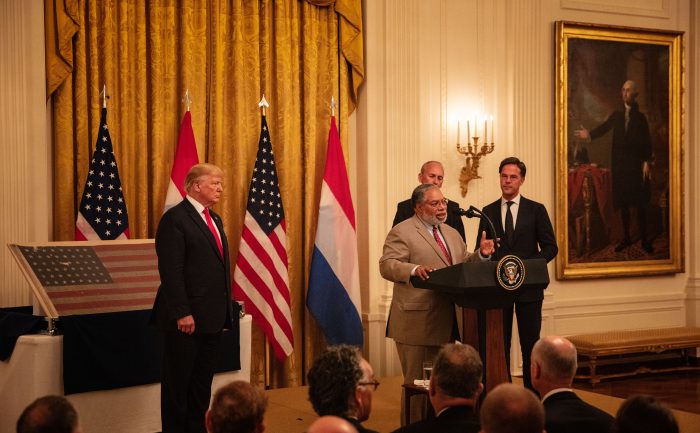
Smithsonian Secretary Lonnie G. Bunch III accepts 48-star D-Day flag at a ceremony at the White House, July 18. (Photo by Jaclyn Nash)
Following a meeting between President Donald J. Trump and Prime Minister Mark Rutte of the Netherlands, Dutch art collectors Bert Kreuk and Theo Schols donated the flag to the people of the United States in memory of the service and sacrifices made by all Americans in the liberation of Europe during World War II.
“One of the key goals of the Smithsonian is to help America remember the moments such as D-Day that forever shaped our nation,” Bunch said. “On this year commemorating the Allied landing on Normandy 75 years ago, this flag is a fitting tribute to all who risked their lives for freedom.”

Smithsonian Secretary Lonnie G. Bunch III accepts 48-star D-Day flag at a ceremony at the White House, July 19. (Photo by Jaclyn Nash)
Bunch was joined at the White House by Anthea M. Hartig, the Elizabeth MacMillan Director of the National Museum of American History, and three museum staff.
The 30-by-57-inch flag features two steel grommets set in a canvas edge and 48 stars representing the existing states. The banner shows discoloration and staining from diesel exhaust along with general wear and tear sustained during the war-time use. One symmetrical hole in blue field flag appears to have come from a German machine gun bullet. Additional moth damage and other fading and discoloration occurred after the war.
This is an edited version of a post that was orginally published by the American History Museum blog, O Say Can You See. Jennifer Jones is a curator in the Office of Curatorial Affairs and Frank Blazich Jr. is a curator in the Division of Political and Military History.
Posted: 23 July 2019
-
Categories:
American History Museum , Feature Stories , History and Culture








